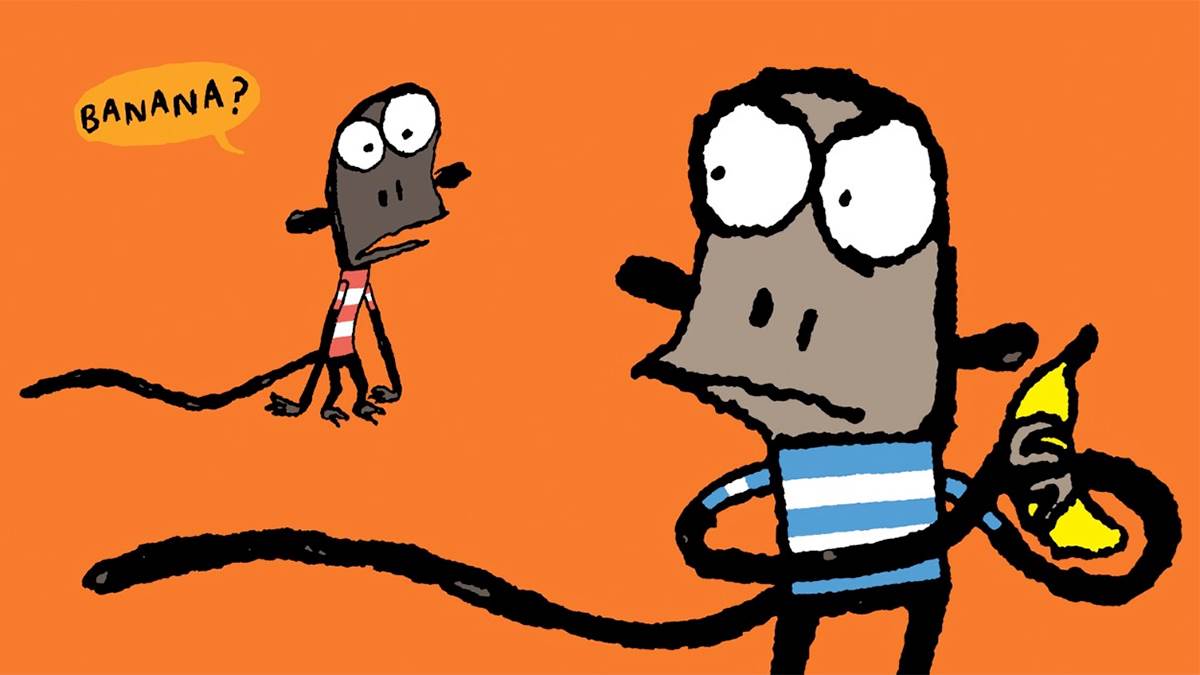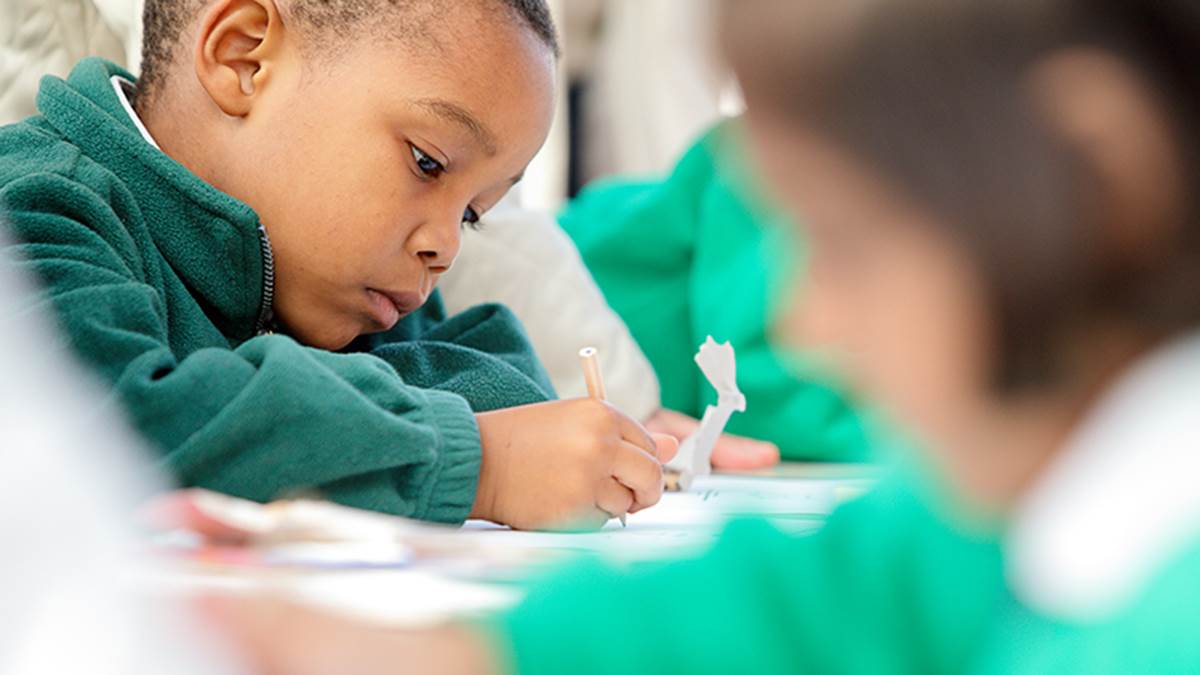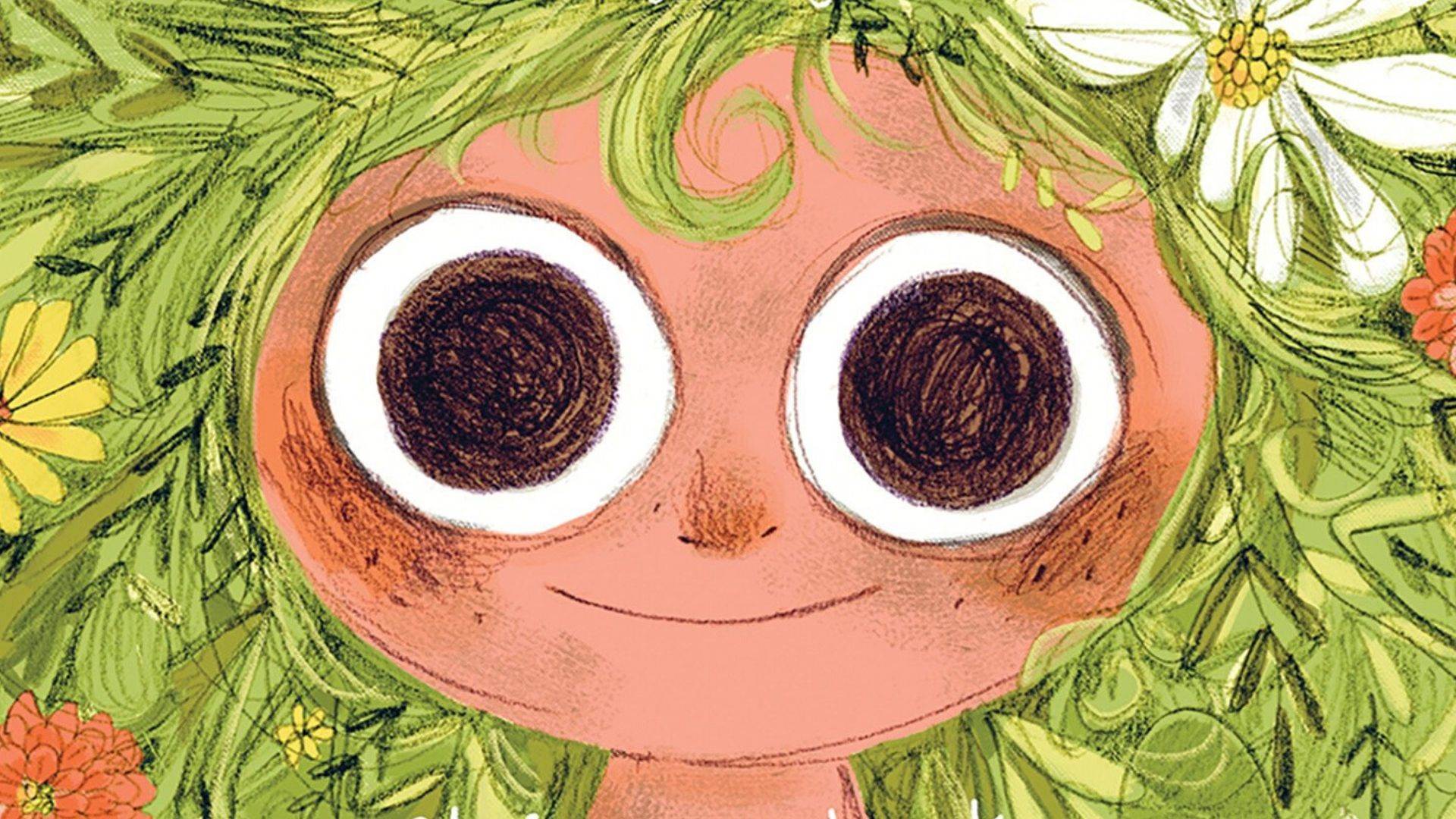Ed Vere on the Power of Pictures
Published on: 17 June 2020
Our Illustrator in Residence, Ed Vere, is passionate about the power of art and drawing in aiding children's development. He talks about his involvement with the Centre for Literacy in Primary Education (CLPE) in getting children drawing.

Over the past few years, I've been working with the Centre for Literacy in Primary Education (CLPE)'s Power of Pictures project, a course I helped co-create with the brilliant Charlotte Hacking. This is a project designed for primary school teachers and children, with the aim of increasing their knowledge of how picture books actually work. How words and pictures work together to tell the story.
Sometimes we can find that teachers and parents concentrate on what the words are saying and don't always realise that the pictures are a very big part of how the story is told. Sometimes, pictures can even tell the story on their own. We use the term visual literacy for what we're teaching, something that is understood innately by children.
We think that if we can teach how to 'read' pictures fully, to give them as much time as the words, it can help teachers to use picture books with children to drastically improve their language, writing and literacy skills... in a language that children understand... and love.
As well as teachers, I think it's great for parents to be able to understand how important drawing is for their children's development.
The project teaches teachers to help children with their creative writing. As we were developing the course, I realised how differently I and a lot of the writers I knew went about writing. Very differently to how we were taught in schools, where some of us (including me) struggled. As adults writing books, we were often using drawing to develop our ideas before we wrote a single word. We use drawing to create and explore characters and the worlds they live in.
Telling stories in different ways
I wondered why drawing wasn't being used in schools, especially with people who found writing more of a struggle. The key thing is give teachers confidence with their own drawing and demonstrate just how much is going on in the pictures, so they can use that with children. Our challenge is to get an idea to start living in a child's head. If that happens more easily by drawing first, great!
My friend Tim Hopgood, who also creates children's books, came and worked with teachers and kids on this project. He said:
'I witnessed at first hand the power of starting the writing process by drawing. That may sound strange to some, but children who had previously struggled to transfer an idea in their heads on to paper grew in confidence as their ideas took shape on the page. Using words and pictures with a greater understanding of how the two can work together is when the magic starts to happen.'
We've been very lucky to have the talents of some brilliant picture book makers to help us grow 'Power of Pictures'; Alexis Deacon, Viv Schwarz, Benji Davies, Chris Haughton, David Lucas, Mini Grey, Emily Hughes, Tom McLaughlin, Tim Hopgood and Joe Todd-Stanton.
We are all published writers, but many of us often found drawing much more accessible than writing when we were at school. For us, and for many children – maybe your children – it helps us to draw before we write, and while we write. Drawing is how we express what we're feeling about the world, before we've found the words to do it, and in ways that words can't. In a similar way, we also learnt to 'read' pictures as well as reading words.
Pictures tell you stories in different ways to words. There's nothing concrete about a picture - it is full of ambiguities and possibilities. Pictures can be read in many different ways, with many different interpretations. Which means they are engaging the imagination... massively!
A similar thing happens when we draw. It allows a looser form of thinking than when we write. Nothing is concrete. The mind moves in a different way... very creatively. There are no spelling mistakes, no issues with punctuation or grammar. We draw a circle... which becomes an eye... which belongs to... a grumpy looking elephant... who is sitting in a rocket ship... exploring the outer reaches of a distant galaxy.
It's a much less intimidating way of getting into what will become a written project. It really does encourage an idea to start living in a child's mind before a single word has had to be written.
Picture books aren't just for little ones
There's a perception that picture books are only for the very young, and when kids get to four or five, they should have 'moved on' to chapter books. One of the wonderful things about this course is that it shows teachers (and I hope parents) how much extremely rich content there is in a picture book for older children.
Picture books are indeed perfect for four and five and six year olds, but if you unpack what is happening in the pictures, they're also chock full of meaning, emotional content, humour, knowledge and interest for much older kids (and, dare I say it, adults!). A parent said:
'One of the interesting things about the Power of Pictures is that, often, the teachers working with us are using picture books with children quite a lot older than you might expect, with great results. Children don't stop loving pictures, formal education just tends to completely ignore them.
'Since doing the Power of Pictures project at school, my son hasn't stopped talking about books and drawing. I never realised how much an older child could get from a picture book. I've been telling him that these books are too young for him and pushing him to read longer books, but I've never seen him so engaged. Not just in reading - now he's drawing and making his own books and talks about being an author. I now realise that it's important that children read all kinds of books.'
One of my books, Banana!, uses only one word: Banana! The story is told using the pictures. Reading the expression of the two monkeys (who are both competing for one banana) and how they happen to say that one word 'Banana!' Differently each time.

Body language and facial expression tells us so much - it's how we first started to understand the world around us. Who was friend, or who was foe. When someone was happy, angry or sad. From birth, we start to understand an incredibly complex set of visual signals – all of which can be expressed through a drawing.
For a five year old, far richer things can be understood through reading a drawing than than reading a word. A child's vocabulary at that age is small, but their 'visual vocabulary' is huge and much more complex than we imagine. There are so many brilliant opportunities to encourage a conversation between the person reading and the person being read to. You might start asking each other how the monkeys look. Does he look sad? Does he look angry? Why is he SO upset? Do you think he might say please? Does he want to share? Those conversations about pictures are important.
But why are they important?

CLPE's research, following the teachers we've trained in this approach, shows that:
When children have increased time looking at picture books it has a positive impact on their understanding of language.
This is because, we think, children learn what words mean and how to use them better when they read them alongside pictures. When we take longer over a book and really look at the pictures and talk about them, children start to understand how to look at something in depth, and therefore, get a depth of understanding for language they might not have had before.
'The most surprising thing is that it has given our children a voice and a language. The developing understanding of how picture books work and how illustrators actively make decisions has led to children digging much more deeply into the story. The increasing understanding that the illustrator is an author has led to in-depth discussions around authorial intent. Pupils increased confidence in expressing understanding and a willingness to challenge ideas has impacted in ways we did not imagine. They have an increasing vocabulary and language to share their ideas.' Project Headteacher
Children understand grammar better when they can see words alongside pictures.
Pictures can show the mood and context for the words. Children can 'see' what the words mean as well as 'know' them.
'Looking at how an author has used language judiciously in the choices they make in a picture book text and the impact this had on them as readers has changed the way the children approach composing a sentence with far more focus on meaning.' Project Teacher, Year 5
Reading picture books give children a solid understanding of story structure that they can use to develop their writing more widely.
Giving time and space for children to read, respond to and discuss the themes and structures of different picture books provides children with a strong understanding of how to construct a compelling story in an accessible way, including characterisation, setting, plot, creating empathy, pacing and structure.
'We've seen a huge impact on the children's understanding of story structure and them being able to use the same level of detail throughout their story, rather than in traditional writing where the introduction and beginning have a lot of detail and then the rest tails off.' Project Teacher
When children are given opportunities to express ideas for characters and stories through drawing, their creativity flourishes and their story ideas are stronger.
So often, children are launched into planning a first draft of writing without having enough time to explore their ideas for a story first. As a writer, I always need a lot of time to think about how a story will work, to work out who a main character is, to get them to live in my head so I know how to write about them. This all needs time and space. Chances to revise your drawing and writing until it feels right. Rushing never helps.
We should understand that when we are asking children to write, they need time. Exploring a character through drawing allows them to really get to know their character, to decide what they are like, how they behave and what their story might be. All this thinking whist drawing gives valuable detail that can be put into their writing.
'Drawing before writing slowed the process down and alleviated the 'stress' of writing, allowing them to gather their thoughts. The variation of lessons and amount of writing has allowed many more of my pupils to gain confidence with drawing and learn not to be afraid of writing.' Project Teacher, Year 5
When children talk about pictures, their communication skills improve.
'What's been particularly note-worthy is the spontaneity as well as richness of the child-led discussions. They are debating points and questions that I'd planned to ask, before I've asked them. Just by turning over and looking at an image, the room was alive with animated and high quality paired talk. Focussing on giving time for deep discussion was fabulous, fully engaging and had impact on their comprehension.' Project Teacher, Year 5

The cover of Wild by Emily Hughes
SO!
In conclusion, if your kids are drawing a lot, FANTASTIC! If they're not, encourage them to... and remind them that there's no such thing as a mistake when you draw! It makes it less intimidating! It's such a fun, valuable skill which helps to teach us to think creatively and helps us to express our emotions. The evidence shows that kids who draw are more confident to write in school and their writing is more descriptive.
Second, looking at picture books, and 'reading' the pictures with your older and younger kids can improve their language skills. It's also fun. Look for the details.
Third... Happy drawing!
And here are some tips for maximum enjoyment:
Tips for Drawing
Encourage your kids to draw. Give them positive feedback, especially if they don't think their drawing is very good. Tell them that mistakes are fine – in fact, they're a big part of how we learn and get better. Tell them what you like – the shapes, the colours, a funny expression. Ask them questions about it; What is this character called? Do they feel happy or sad? Where are they going? What are they thinking? What else could you add to the picture?
If they're not feeling confident, use one of my how to draw videos. Maybe you can all do the drawing step-by-step together! They'll soon see that all of your drawings are different – and also see that you, as adults, are just as unsure about drawing as them! In a way, that's quite reassuring.
You can also encourage kids to draw what they see in front of them. Things around the house, animals, chairs, brothers, sisters, parents. Make it fun. They can draw what they see on TV. You can have competitions to see who can do the best caricature of someone on TV. Or watch a nature documentary and try to draw an elephant or a lion. Keep telling them that it doesn't matter if they make a mistake – that's how you learn!
You could also trace over illustrations of your favourite book characters to gain a feel for the lines, shapes and patterns used by an illustrator. The ideas they'll gain from following someone else's drawing will give them their own ideas.
You could also draw with them. They will LOVE to see your drawings! Again, don't worry if you don't think your drawing is brilliant. It's just fun to do it together – and no doubt they will love what you do because you've done it, just as you love what they've drawn because they did it!
It's also fun to see how authors or illustrators of some of your favourite picture books make their pictures and write their stories. The draw alongside an illustrator videos on the CLPE website allow you to follow a step-by-step guide to drawing a range of characters, experimenting with different materials, and building whole worlds that you can then write about.
And primary teachers, please have a look at CLPE's Power of Pictures website. It's a free resource full of amazing ideas about how to use picture books and drawing with your students. We've found it's given so much confidence to children with their creative writing, especially those who may have been the most reluctant. Allowing drawing into the process has been truly transformative in how it engages. If you'd like to add your voice or find out more, please get in touch with us at CLPE. We want to spread these ideas far and wide.
Tips for sharing picture books with your older kids
- Don't assume children are too old for picture books. Picture books are often a lot more sophisticated than you'd expect, and there are a lot of clues, themes and details that little ones won't pick up – but an eight or ten-year-old will. Picture books like Voices in the Park by Anthony Browne, A Mouse Called Julian by Joe Todd-Stanton, Grandad's Island by Benji Davies and Wild by Emily Hughes are perfect for older kids.
- Talk about the colours in the pictures and how they make you feel. Are there lots of shadows or dark colours? Is there a limited set of colours in the book? Do they provide a general mood?
- Examine the body language and facial expressions of the characters. You can talk about what you think a character is feeling from reading the body language – there will be room for different interpretations, as we all see things differently. There's room for lots of conversation about why certain emotions are being felt. My book Banana is a good one for exploring all sorts of feelings and emotions: sibling rivalry, anger, expectation, jealousy, upset, joy, happiness.
- Is there an interesting use of perspective, size or measurement in the illustrations? That is, does one character look larger than the rest, or does something loom over something else? How does that make you feel as the reader?
- What details are in the background? What do they make you think about what's going on in the story? Do they contradict what a character might be saying? Do they give an air of menace, comfort, homeliness?
- How does the text interact with the illustration? Where does it sit on the page? Is it laid out in an interesting way? What do the words say that the pictures do not? And what do you see in the illustrations that you don't get from the text? Are the pictures telling you something that the words don't?
Topics: Writer in Residence, Features, Ed Vere





